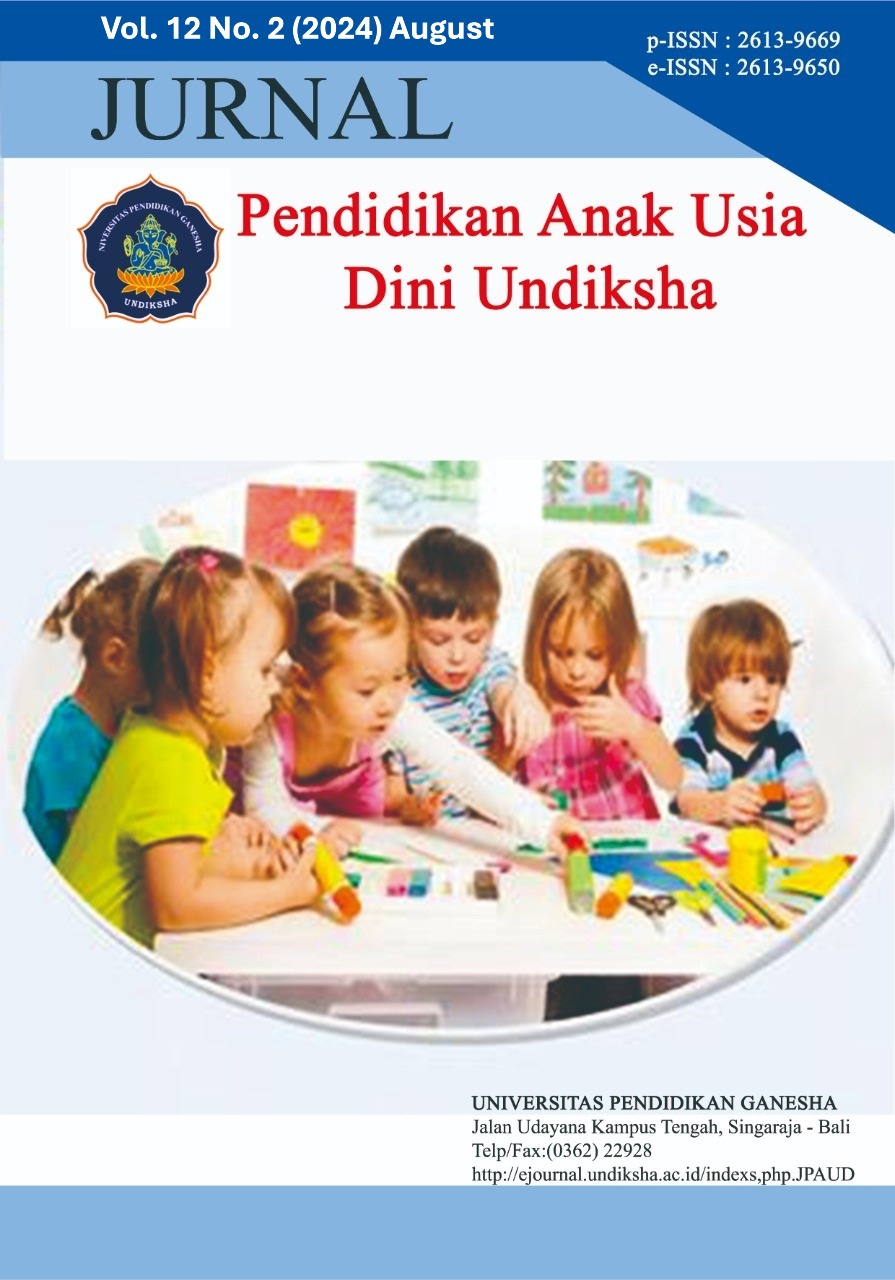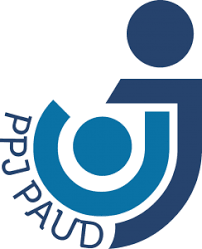Enhancing Early Childhood Education through a Local Wisdom-Based K4 Pillar Module with an Ethnoscience Approach
DOI:
https://doi.org/10.23887/paud.v12i2.69812Keywords:
K4 Pillar Module, Local Wisdom, Ethnoscience, Early Childhood EducationAbstract
The learning environment in early childhood education institutions still faces challenges in implementing the values of cleanliness, neatness, health, and security (K4 Pillars). This study aims to develop a K4 Pillar module based on local wisdom through an ethnoscience approach within the context of early childhood education. The research employs the Educational Design Research (EDR) method to produce an innovative educational product. The subjects of the study include randomly selected early childhood students and teachers. Data collection methods encompass questionnaires, observations, and interviews. Data analysis utilizes statistical techniques for quantitative data and thematic analysis for qualitative data. The research findings indicate that the majority of students (87.5%) strongly support the use of the module as a learning tool, emphasizing its critical role in early childhood education. However, most teachers (62.5%) did not attempt to link the module with local wisdom, and 75% did not employ an ethnoscience approach, highlighting the need for increased teacher engagement in integrating local cultural elements and ethnoscience concepts into teaching. High levels of support from both students and teachers (87.5%) for the local wisdom-based module with an ethnoscience approach underscore its potential to enhance the effectiveness of early childhood education. The study concludes that the local wisdom-based module with an ethnoscience approach has significant potential to improve the effectiveness of early childhood education.
References
Alfatease, A., Alqahtani, A. M., Orayj, K., & Alshahrani, S. M. (n.d.). The impact of social media on the acceptance of the COVID-19 vaccine: a cross-sectional study from Saudi Arabia. Patient Preference and Adherence, 2673–2681. https://www.tandfonline.com/doi/full/10.2147/PPA.S342535#d1e174.
Alwi, S., & Iqbal, M. (2022). Examining Peurateb Aneuk Text As A Model For The Religious Character Building In Early Childhood. Journal of Contemporary Islam and Muslim Societies, 6(2). https://doi.org/10.30821/jcims.v6i2.12834.
Anderson-Levitt, K. (2003). Local Meanings, Global Schooling: Anthropology and World Culture Theory. Palgrave Macmillan US.
Aningsih, ., Zulela, M., Neolaka, A., Iasha, V., & Setiawan, B. (2022). How is the Education Character Implemented? The Case Study in Indonesian Elementary School. Journal of Educational and Social Research, 12(1), 371. https://doi.org/10.36941/jesr-2022-0029.
Arikunto, S. (2010). Prosedur Penelitian: Suata Pendekatan Praktek. Rineka Cipta.
Arsih, F., Alberida, H., Rahmi, Y. L., & Khalel, N. Z. (2023). Analysis of Digital Book Integrated Local Culture as the Internalization of Character Education During Pandemic (pp. 18–26). https://doi.org/10.2991/978-94-6463-166-1_4.
Atmojo, S. E., Lukitoaji, B. D., & Muhtarom, T. (2021). Improving Science Literation and Citizen Literation Through Thematic Learning Based on Ethnoscience. Journal of Physics: Conference Series, 1823(1), 012001. https://doi.org/10.1088/1742-6596/1823/1/012001.
Cascini, F., Pantovic, A., Al-Ajlouni, Y. A., Failla, G., Puleo, V., Melnyk, A., Lontano, A., & Ricciardi, W. (2022). Social media and attitudes towards a COVID-19 vaccination: A systematic review of the literature. EClinicalMedicine, 48, 101454. https://doi.org/10.1016/j.eclinm.2022.101454.
Dewi, C. A., Khery, Y., & Erna, M. (2019). An Ethnoscience Study in Chemistry Learning to Develop Scientific Literacy. Jurnal Pendidikan IPA Indonesia, 8(2). https://doi.org/10.15294/jpii.v8i2.19261.
Efendi, M. H., & Muliadi, A. (2023). Ethnoscience-based science learning in sasak ethnic culture: literature review. Jurnal Penelitian Pendidikan IPA, 9(5), 22–33. https://doi.org/10.29303/jppipa.v9i5.3769.
Fakhriyah, F., Masfuah, S., Roysa, M., Rusilowati, A., & Rahayu, E. S. (2017). Student’s science literacy in the aspect of content science. Jurnal Pendidikan IPA Indonesia, 6(1). https://doi.org/10.15294/jpii.v6i1.7245.
Gayatri, M., & Irawaty, D. K. (2022). Family Resilience during COVID-19 Pandemic: A Literature Review. The Family Journal, 30(2), 132–138. https://doi.org/10.1177/10664807211023875.
Guo, K., Kuramochi, K., & Huang, W. (2017). Learning and learners in early childhood curricula: Australia, Japan and China. Curriculum Perspectives, 37(1), 39–49. https://doi.org/10.1007/s41297-017-0007-9.
Hasan, S., Masud, A., & Sundari, S. (2021). Etnopedagogy approach to science learning in sdn 50 city of ternate based on the local wisdom of Rempah North Maluku. Pedagonal: Jurnal Ilmiah Pendidikan, 5(2), 133–141. https://doi.org/10.33751/pedagonal.v5i2.3789.
Hasani, L. M., Santoso, H. B., & Isal, R. Y. K. (2019). Designing Alternative Interface Design of e-Learning Modules based on Felder-Silverman Learning Styles and User Centered Design Approach. 2019 International Conference on Advanced Computer Science and Information Systems (ICACSIS), 459–464. https://doi.org/10.1109/ICACSIS47736.2019.8979717.
Hay, N. A., Chien, P. M., & Ruhanen, L. (2022). Tell me your story: Branding destinations through residents’ (place) stories. Journal of Vacation Marketing, 28(3), 319–334. https://doi.org/10.1177/13567667211060567.
Hidaayatullaah, H. N., Suprapto, N., Hariyono, E., Prahani, B. K., & Wulandari, D. (2021). Research Trends on Ethnoscience based Learning through Bibliometric Analysis: Contributed to Physics Learning. Journal of Physics: Conference Series, 2110(1), 012026. https://doi.org/10.1088/1742-6596/2110/1/012026.
Hsin, C. T., Liang, J. C., Hsu, C. Y., Shih, M., Sheu, F. R., & Tsai, C. C. (2019). Young children’s conceptions of learning: A cross-sectional study of the early years of schooling. The Asia-Pacific Education Researcher, 28, 127–137. https://doi.org/10.1007/s40299-018-0419-9.
Jihannita, J., Fadly, W., Ekapti, R. F., Luthfiana, D., & Widowati, A. (2024). The Development of Science Module Integrated with Ethnoscience of Singo Barong Mask to Improve Scientific Literacy and Cultural Preservation Attitudes. Journal of Innovation in Educational and Cultural Research, 5(2). https://doi.org/10.46843/jiecr.v5i2.790.
Kannan, S. B. (2022). Clean bodies in school: spatial-material discourses of children’s school uniforms and hygiene in Tamil Nadu, India. Children’s Geographies, 20(6), 803–817. https://doi.org/10.1080/14733285.2022.2059341.
Lee, J. (2023). “Teach what’s good for learners”: Adaptive teacher pedagogy for social and emotional learning in Malawi. International Journal of Educational Development, 102, 102870. https://doi.org/10.1016/j.ijedudev.2023.102870.
Mahyuny, S. R., Nursamsu, N., Hasruddin, H., & Muslim, M. (2022). Development of students worksheet learning tools made by ethnoscience based on science literacy. Jurnal Penelitian Pendidikan IPA, 8(4), 2001–2007. https://doi.org/10.29303/jppipa.v8i4.1949.
Mania, S. (2024). Development of Ethnomathematics-Based Mathematical Teaching Materials at the Makassar 99 Kubah Mosque in Facilitating Student Learning Independence. Jurnal Matematika Kreatif-Inovatif, 15(1). https://doi.org/10.15294/r9qd9r26.
Marito, W. (2023). Pendekatan Etnomatematika Meningkatkan Kemampuan Matematis Siswa. Indo-MathEdu Intellectuals Journal, 4(2), 216–222. https://doi.org/10.54373/imeij.v4i2.155.
McKenney, S., & Reeves, T. C. (2021). Educational design research: Portraying, conducting, and enhancing productive scholarship. Medical Education, 55(1), 82–92. https://doi.org/10.1111/medu.14280.
Meginnis, K., & Campbell, D. (2017). Students’ preferences for attributes of postgraduate economics modules: Evidence from a multi-profile best-worst scaling survey. International Review of Economics Education, 24, 18–27. https://doi.org/10.1016/j.iree.2016.11.001.
Murti, P. R., & Aminah, N. S. (2019). The identification of high school students’ knowledge of newton’s law of science literacy using a test based on nature of science (NOS). In Journal of Physics: Conference Series, 1153(1). https://doi.org/10.1088/1742-6596/1153/1/012122.
Noviana, E., Faizah, H., Mustafa, M. N., Elmustian, Hermandra, Kurniaman, O., Rusandi, M. A., & Situmorang, D. D. B. (2023). Understanding “Tunjuk Ajar Melayu Riau”: Integrating local knowledge into environmental conservation and disaster education. Heliyon, 9(9), e19989. https://doi.org/10.1016/j.heliyon.2023.e19989.
Nuraini, N., Asri, I. H., & Fajri, N. (2023). Development of Project Based Learning with STEAM Approach Model Integrated Science Literacy in Improving Student Learning Outcomes. Jurnal Penelitian Pendidikan IPA, 9(4), 1632–1640. https://doi.org/10.29303/jppipa.v9i4.2987.
Nurcahyani, D., Rahmayanti, H., Ichsan, I. Z., & Rahman, M. M. (2021). Ethnoscience learning on science literacy of physics material to support environment: A meta-analysis research. In Journal of Physics: Conference Series. https://doi.org/10.1088/1742-6596/1796/1/012094.
Pratama, D. H., & Jumadi, J. (2023). Analysis the Implementation of Ethnoscience Approach in Learning Science. Jurnal Penelitian Pendidikan IPA, 9(4), 1615–1620. https://doi.org/10.29303/jppipa.v9i4.2721.
Santos-Meneses, L. F., Pashchenko, T., & Mikhailova, A. (2023). Critical thinking in the context of adult learning through PBL and e-learning: A course framework. Thinking Skills and Creativity, 49(September). https://doi.org/https://doi.org/10.1016/j.tsc.2023.101358.
Saraniemi, S., & Komppula, R. (2019). The development of a destination brand identity: A story of stakeholder collaboration. Current Issues in Tourism, 22(9), 1116–1132. https://doi.org/10.1080/13683500.2017.1369496.
Sari, F. P., Maryati, M., & Wilujeng, I. (2023). Ethnoscience Studies Analysis and Their Integration in Science Learning: Literature Review. Jurnal Penelitian Pendidikan IPA, 9(3), 1135–1142. https://doi.org/10.29303/jppipa.v9i3.2044.
Sastradika, D., & Jumadi, J. (2018). Development Of Subject-Specific Pedagogy Based On Guided Inquiry About Newton’s Law To Improve Senior High School Students’ Scientific Literacy Ability. Unnes Science Education Journal, 7(2). https://doi.org/10.15294/usej.v7i2.23722.
Wade, M., Wright, L., & Finegold, K. E. (2022). The effects of early life adversity on children’s mental health and cognitive functioning. Translational Psychiatry, 12(1), 244. https://doi.org/10.1038/s41398-022-02001-0.
Whaley, G. L., & Pfefferbaum, B. (2023). Parental challenges during the COVID-19 pandemic: psychological outcomes and risk and protective factors. Current Psychiatry Reports, 25(4), 165–174. https://doi.org/10.1007/s11920-023-01412-0.
Zhao, L.-T., Wang, D.-S., Liang, F.-Y., & Chen, J. (2023). A recommendation system for effective learning strategies: An integrated approach using context-dependent DEA. Expert Systems with Applications, 211, 118535. https://doi.org/10.1016/j.eswa.2022.118535.
Zidny, R., & Eilks, I. (2022). Learning about Pesticide Use Adapted from Ethnoscience as a Contribution to Green and Sustainable Chemistry Education. Education Sciences, 12(4), 227. https://doi.org/10.3390/educsci12040227.
Downloads
Published
How to Cite
Issue
Section
License
Copyright (c) 2024 Muhammad Iqbal, Widya, Muttakin, Noval Fuadi, Maya Safitri

This work is licensed under a Creative Commons Attribution-ShareAlike 4.0 International License.
Authors who publish with the Jurnal Pendidikan Anak Usia Dini Undiksha agree to the following terms:
- Authors retain copyright and grant the journal the right of first publication with the work simultaneously licensed under a Creative Commons Attribution License (CC BY-SA 4.0) that allows others to share the work with an acknowledgment of the work's authorship and initial publication in this journal.
- Authors are able to enter into separate, additional contractual arrangements for the non-exclusive distribution of the journal's published version of the work (e.g., post it to an institutional repository or publish it in a book), with an acknowledgment of its initial publication in this journal.
- Authors are permitted and encouraged to post their work online (e.g., in institutional repositories or on their website) prior to and during the submission process, as it can lead to productive exchanges, as well as earlier and greater citation of published work. (See The Effect of Open Access)











